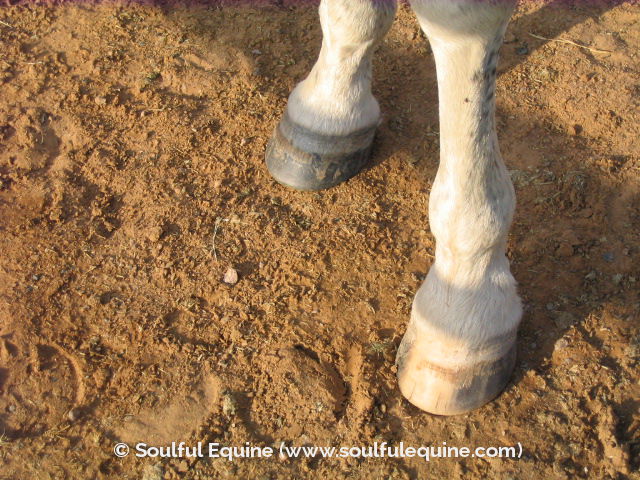 Stephanie’s Barefoot Horse (Front Hooves) – Faith
Stephanie’s Barefoot Horse (Front Hooves) – FaithWhat’s a sound barefoot horse?
Is taking your equine partner barefoot all that hard? Many people think so.
Some believe it’s this mystical thing that includes some form of voodoo and only some horses are capable of being barefoot.
Is this true?
I’ve heard on multiple occasions, especially from certain experts, that it’s all about survival of the fittest. Pick up almost any traditional horse publication that decided to publish (because it was trendy or popular) an article about going barefoot, and you’ll find some “expert” using that excuse.
It’s usually a well-respected lameness vet who’ll make such statements. I can’t tell you how many times I’ve read something like that and then thought to myself, “I wouldn’t allow that person within 10 feet of my horse”, and they’re well respected and experts in lameness.
How interesting.
Those same individuals say we shouldn’t compare our domesticated horses to wild horses. Actually, they’re correct, because our domesticated horses can’t hold a candle to the wild ones when it comes to soundness and health.
I would say that’s a problem for our domesticated partners – wouldn’t you?
Here I am using the word “soundness” and most people don’t understand what that means. Usually a soundness problem doesn’t become a soundness problem in someone’s eyes until the horse can’t walk, is obviously limping or is what people refer to as dead lame.
In reality, most horses are not sound. The majority of equine guardians miss the subtle signs, so their horses continue to compensate for their soundness problems. Horses are masters at survival, which means they will adjust and compensate until they can’t. This is one reason most lameness cases are overlooked.
Plus, a lot of soundness issues are covered up by metal shoes.
So, what’s your excuse for not taking your horse barefoot?
I believe most people don’t think about it until it becomes necessary. Meaning, they’re forced to go barefoot thinking they can possibly rehabilitate their lame horse.
As I share in my book on natural horse care concepts, I was one of those people. What was my excuse? I didn’t have one. I was ignorant and the barefoot movement was still new. That was back in 2001 – many years ago.
A lot has changed in since then, but there’s still a long way to go. There have been many well-known traditional publications that have published articles on barefoot. This is a good start, but each time I read one of those articles, I’m usually disappointed and I notice a common denominator that I consider a concern.
What is the Common Denominator That Most People Ignore?
That common denominator is direct line thinking.
If we only focus on the hoof, as most do, barefoot will not work.
The hard truth is that barefoot is for every horse, but it’s not for every human.
So, when someone says, “Barefoot doesn’t work,” they’re right. They’re probably one of the individuals for whom going barefoot just won’t work.
What I’ve Observed From the Barefoot Movement
I’ve observed a lot of things from the barefoot movement over many years of study and application. The one thing that sticks out like a sore thumb is that most people have no idea that there’s a horse keeping principles priority list that must be implemented, or barefoot will not work.
What do I mean?
There is a list of core principles I share with all my customers. I came up with this priority list from my years of study and experience.
The key to this list is in the words principles and priority.
In essence, they’re fancy terms for natural horse care.
What if We Approached Barefoot in the Opposite Manner?
What if natural hoof care professionals were up front in the beginning and let people know that the hoof is just a by-product of everything else we do in our horse keeping practices?
Most natural hoof care providers will argue that they already do this, but do the words natural horse care come out of their mouths from the beginning?
Usually what I hear is the statement, “It’s not just about the hoof.” That’s a common one, and it’s true.
However, let’s stop using that saying and create a mind shift that we start from the beginning – call it what it really is!
Natural Horse Care.
By default, we will address the hoof along the way plus most of those other problems you’ve been complaining about. By default, most issues will be resolved.
I’m going to leave you with this thought:
Basically, if you want to take your horse barefoot and have her stay sound, you have to adopt a natural horse care lifestyle.” ~ Stephanie Krahl
Share with Us What Your Excuse Is for Not Going Barefoot
I know that taking your horse barefoot can be a big commitment in the beginning. So, I understand if you haven’t done it yet. However, I would still love for you to share with me your thoughts or fears about going barefoot. What are your concerns, if you have any? What’s keeping you from making that leap?
If you liked this article, please share it with your horsey friends on Facebook or tweet about it on Twitter.
Keep it soulful,
Stephanie Krahl
